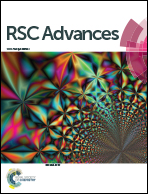Degradation and detoxification of methylene blue dye adsorbed on water hyacinth in semi continuous anaerobic–aerobic bioreactors by novel microbial consortium-SB†
Abstract
Combinatorial adsorption–biodegradation treatment of textile wastewater provides a cost effective and ecofriendly alternative to conventional physicochemical treatment methods. Water hyacinth plant powder (WHPP) was used for adsorption of cationic dye methylene blue. Adsorption of methylene blue on WHPP was found to follow pseudo second order kinetics. The toxicity, chemical oxygen demand (COD), biological oxygen demand (BOD), alkalinity and hardness of filtrate were significantly reduced after adsorption of methylene blue on WHPP. The decolorization of dye adsorbed on WHPP was performed in semi continuous anaerobic sludge bioreactor and aerobic trickling bed bioreactor. The percentage of dye removal was comparatively higher in single anaerobic treatment while significant reduction in COD, BOD, alkalinity, hardness and toxicity were observed in semi continuous aerobic treatment (flow rate 80 mL h−1) than in anaerobic treatment. Degradation of methylene blue after semi continuous anaerobic–aerobic treatment was confirmed by HPLC analysis.


 Please wait while we load your content...
Please wait while we load your content...